












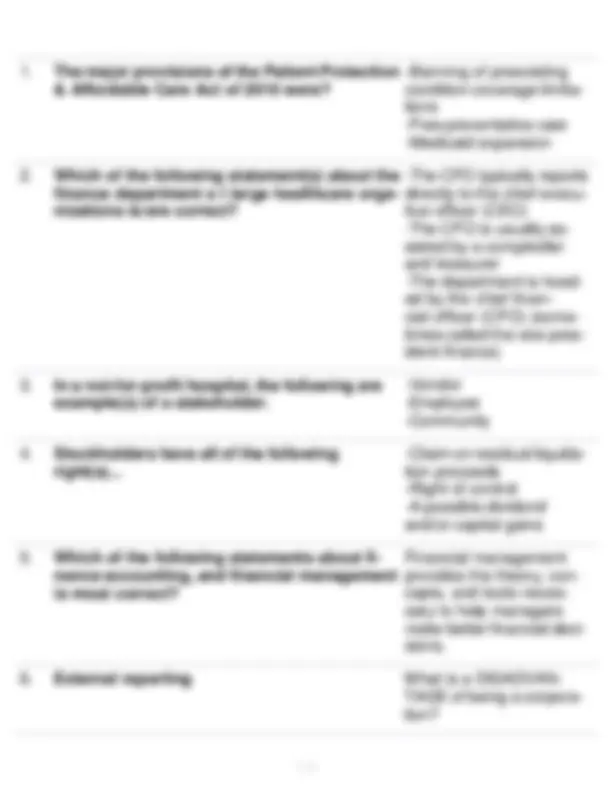
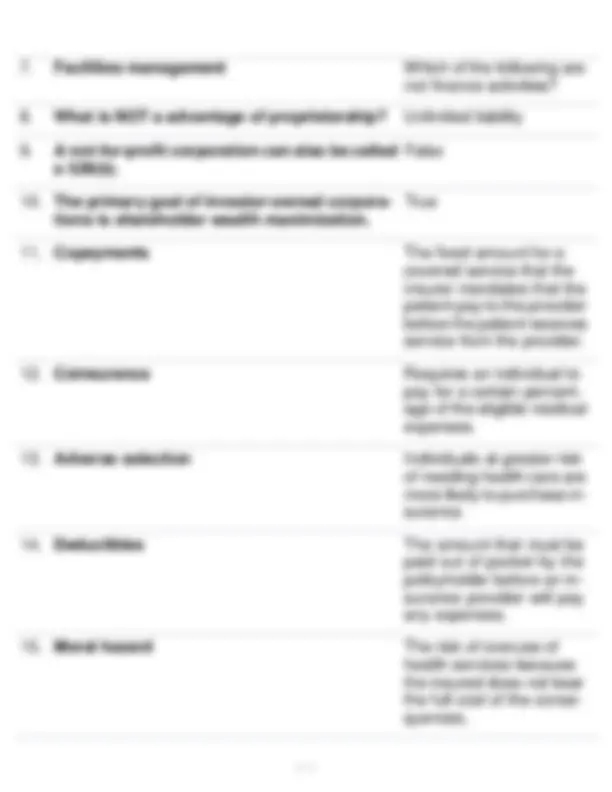
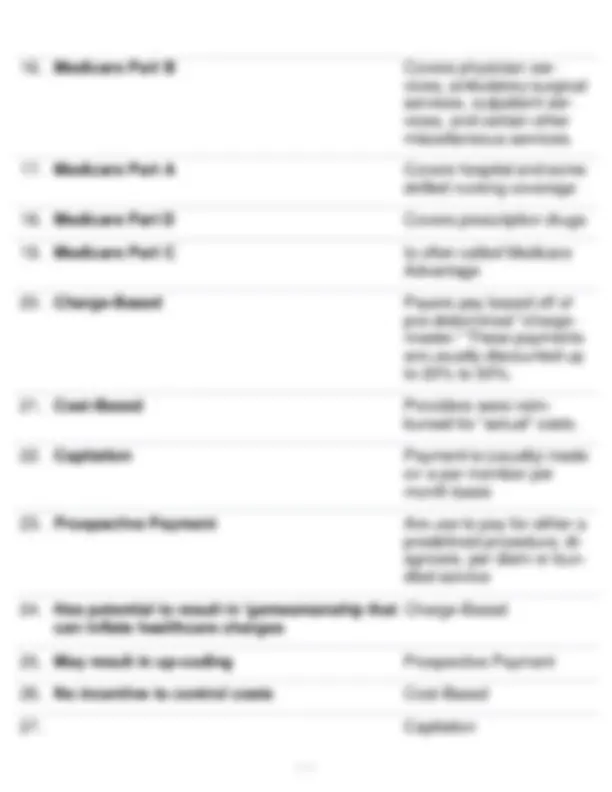
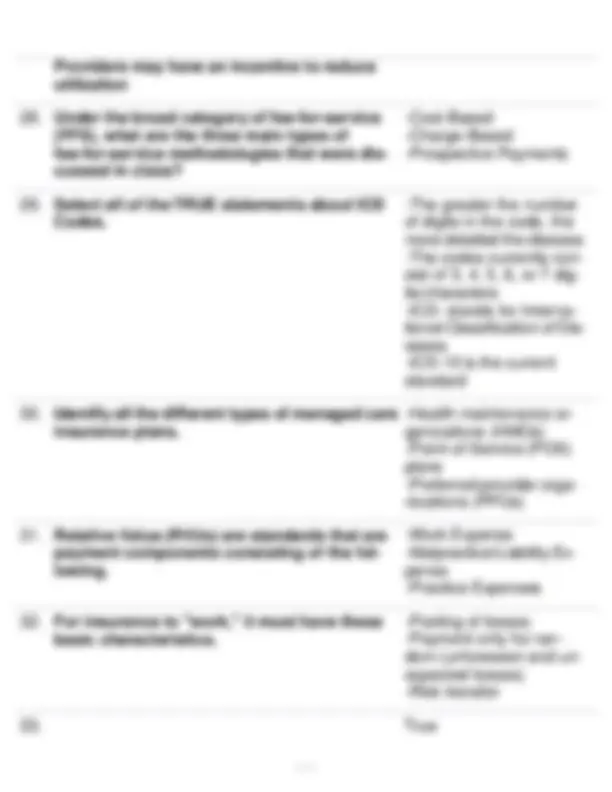
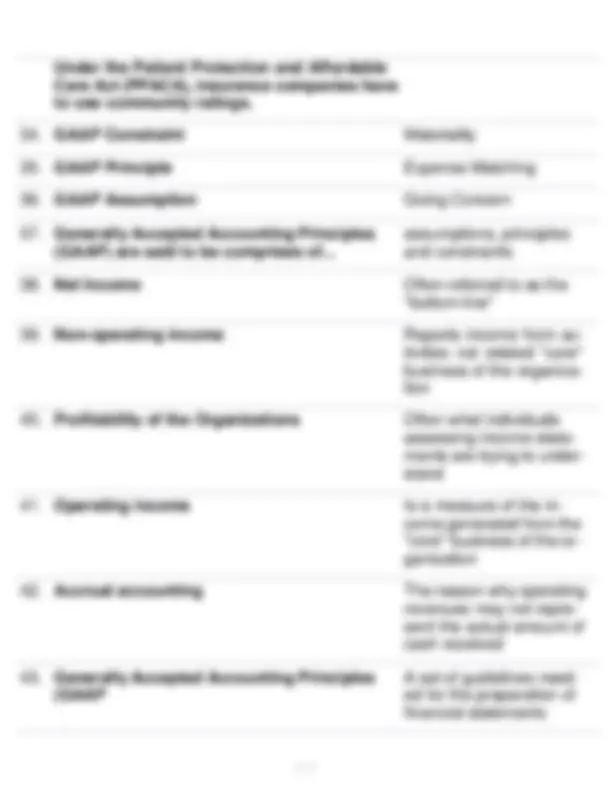
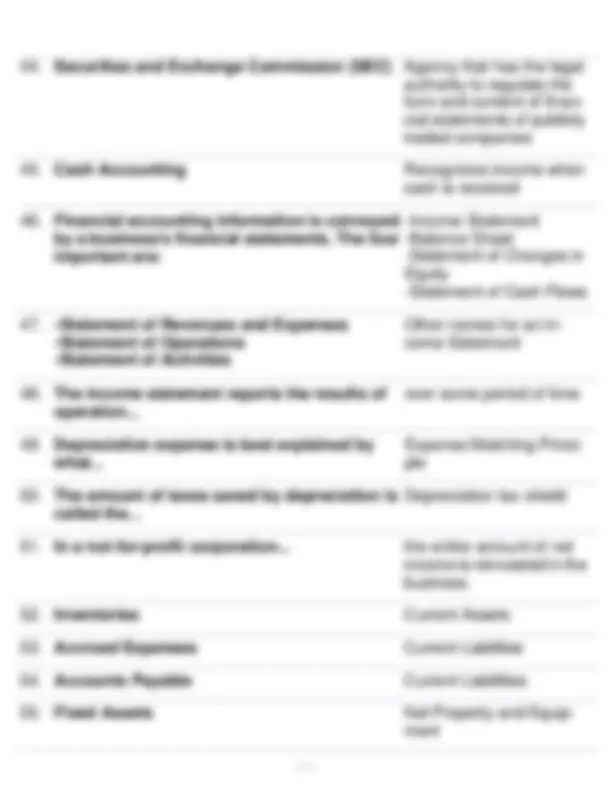
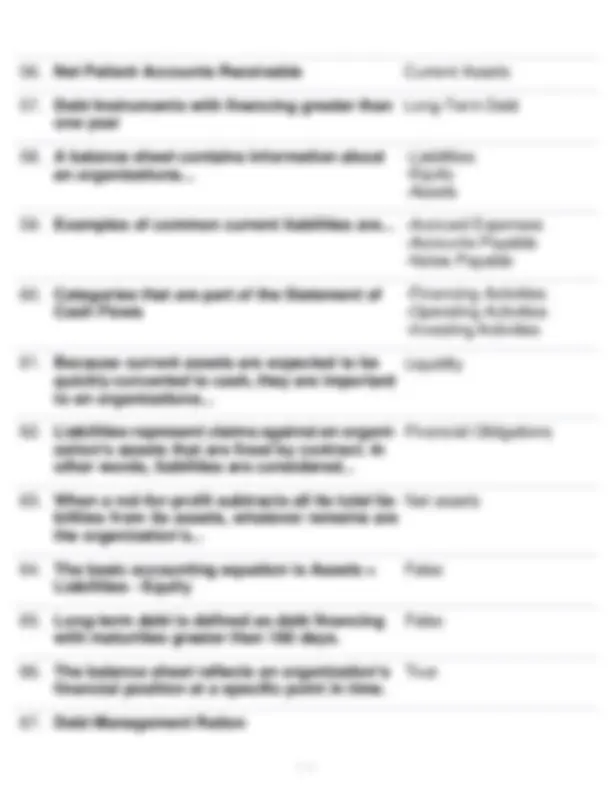
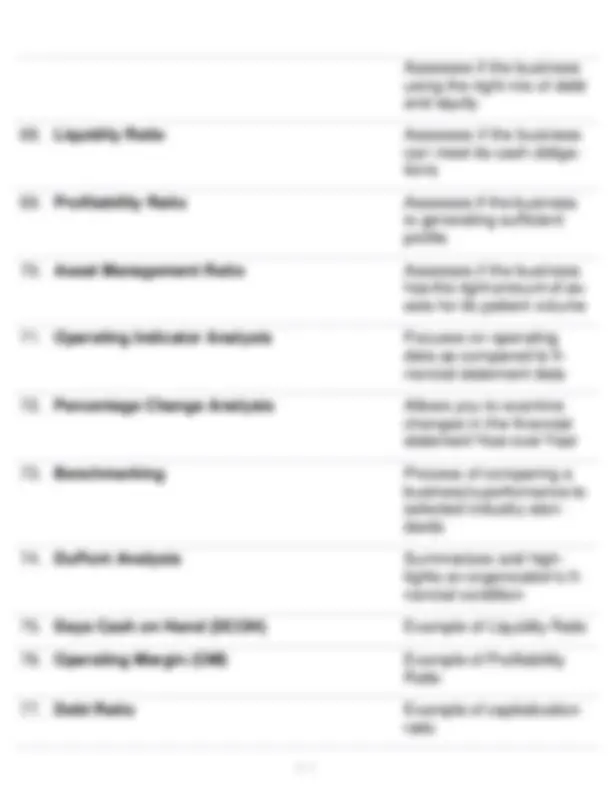
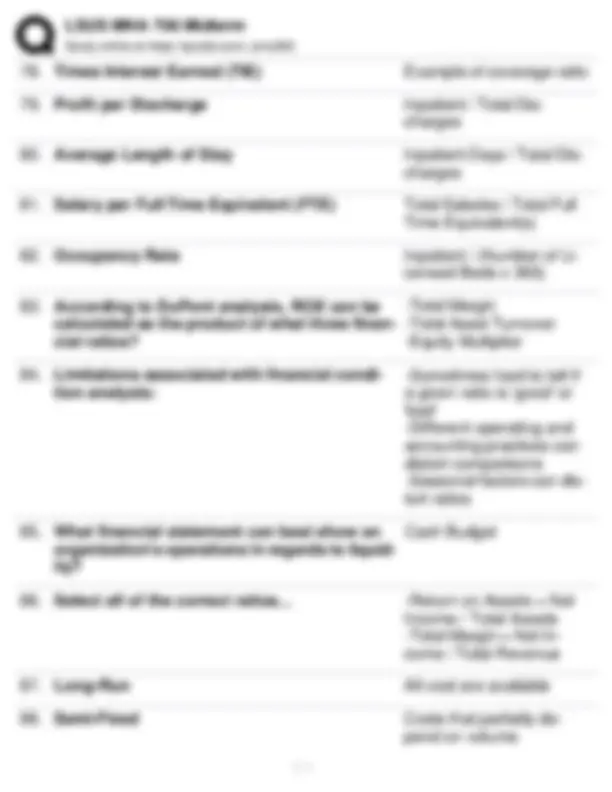
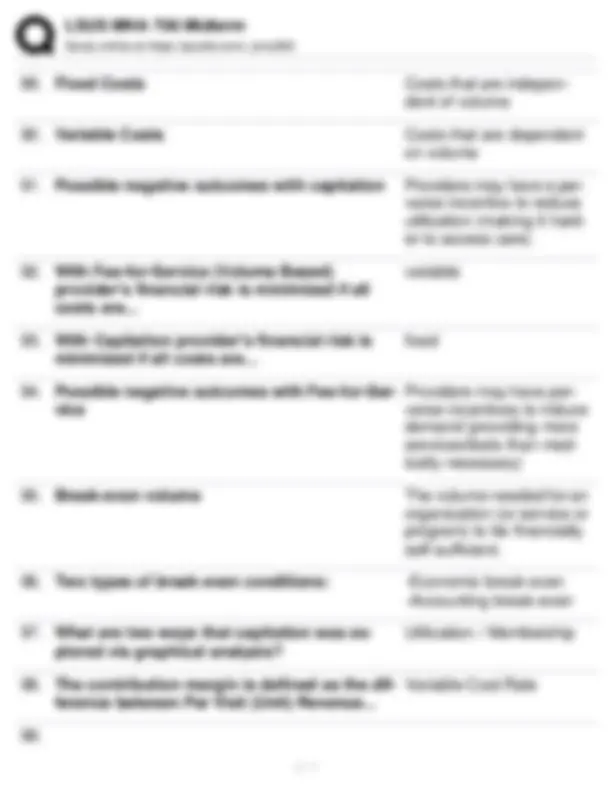



Study with the several resources on Docsity

Earn points by helping other students or get them with a premium plan


Prepare for your exams
Study with the several resources on Docsity

Earn points to download
Earn points by helping other students or get them with a premium plan
Community
Ask the community for help and clear up your study doubts
Discover the best universities in your country according to Docsity users
Free resources
Download our free guides on studying techniques, anxiety management strategies, and thesis advice from Docsity tutors
LSUS MHA 706 MIDTERM EXAM STUDY GUIDE 2024 | FINANCIAL MANAGEMENT MIDTERM | QUESTIONS AND CORRECT ANSWERS | LATEST VERSION | ALREADY GRADED A+
Typology: Exams
1 / 31

This page cannot be seen from the preview
Don't miss anything!
























healthcare finance -------------------------------the accounting and financial management principles and practices used within health services organizations to ensure the financial well-being of the enterprise healthcare sector -------------------------------consists of a diverse collection of industries that involve the healthcare of the population provider -------------------------------an organization that provides healthcare services business -------------------------------maintains financial viability by selling goods or services pure charity -------------------------------relies solely on contributions finance -------------------------------consists of both accounting and financial management functions primary role of finance -------------------------------to plan for, acquire, and use resources to maximize the efficiency and value of the enterprise
accounting -------------------------------concerns the recording of economic events that reflect the operations, resources, and financing of an organization financial management -------------------------------provides the theory, concepts, and tools necessary to help managers make better financial decisions planning and budgeting -------------------------------involves evaluating the financial effectiveness of current operations and planning for the future financial reporting -------------------------------recording and reporting to outsiders the results of operations and current financial status capital budgeting -------------------------------the process of analyzing and choosing new fixed assets financing decisions -------------------------------all organizations must raise capital to buy the assets necessary to support operations working capital management -------------------------------a managerial accounting strategy focusing on maintaining efficient levels of both components of working capital, current assets and current liabilities, in respect to each other contract management -------------------------------the process of managing contract creation, execution and analysis to maximize operational and financial performance at an organization, all while reducing financial risk financial risk management -------------------------------the practice of economic value in a firm by using financial instruments to manage exposure to risk, particularly credit risk and market risk
general acute care hospitals -------------------------------provide general medical and surgical services and selected acute specialty services tertiary care -------------------------------highly specialized and technical in nature, with services for patients with unusually severe, complex, or uncommon problems governmental hospitals -------------------------------federal and public entities federal hospitals -------------------------------operated by military services or the US Department of Veterans Affairs public hospitals -------------------------------funded wholly or in part by a city, county, tax district, or state private not-for-profit hospitals -------------------------------nongovernmental entities organized for the sole purpose of providing inpatient healthcare services investor-owned corporations -------------------------------a for-profit business whose capital is supplied by owners not-for-profit corporations -------------------------------a corporation that has a charitable purpose, is tax exempt, and has no owners third-party payer -------------------------------an entity other that the patient that pays for healthcare services
ambulatory or outpatient care -------------------------------encompasses services provided to non institutionalized patients long-term care -------------------------------healthcare services that cover an extended period of time, often with a focus on mental health skilled nursing facilities -------------------------------provide the level of care closest to hospital care intermediate care facilities -------------------------------intended for individuals who do not require hospital or SNF care but whose mental or physical conditions require daily continuity of one or more medical services residential care facilities -------------------------------sheltered environments that do not provide professional healthcare services integrated delivery system -------------------------------a single organization that offers a broad range of healthcare services in a unified manner licensure -------------------------------the granting or regulation of licenses, as for professionals certificate of need -------------------------------An endorsement required by numerous states before the construction of a new health care facility will be approved professional liability -------------------------------protects professionals such as accountants, lawyers and physicians against negligence and other claims initiated by their clients
primary market -------------------------------the market in which newly issued securities are sold for the first time secondary market -------------------------------the market in which previously issued securities are sold publicly held company -------------------------------a corporation whose shares are held by the general public privately held company -------------------------------shares are held by a small number of individuals, usually the managers stockholders -------------------------------owners of investor-owned corporations board of directors -------------------------------oversees the management of the company proxy -------------------------------a document giving one person the authority to act for another - typically the power to vote shares of common stock residual earnings -------------------------------any excess of revenues over expenses dividend -------------------------------the periodic payment paid to owners of common and preferred stock form 990 -------------------------------a form filed by not-for-profit organizations with the IRS that reports on governance and charitable activities
schedule H -------------------------------an attachment to form 990 filed by not-for-profit hospitals that gives additional information on charitable activities shareholder wealth maximization -------------------------------stock price maximization agency problem -------------------------------a conflict of interest that can arise between principals and agents Medicare -------------------------------a federal government health insurance program that provides benefits to individuals aged 65 or older Medicaid -------------------------------a federal and state government health insurance program that provides benefits to low-income individuals managed care plans -------------------------------strive to combine the insurance function and the provision of healthcare services health maintenance organization ------------------------------- fee-for-service -------------------------------a reimbursement methodology that provides payment each time a service is provided capitation -------------------------------a reimbursement methodology that is based on the number of covered lives as opposed to the amount of services provided cost-based reimbursement -------------------------------a reimbursement methodology based on the costs incurred in providing services
Healthcare Common Procedure Coding System (HCPCS) -------------------------------a medical coding system that expands the CPT codes to include nonphysician services durable medical equipment healthcare reform -------------------------------generic term used to describe the actions taken by Congress in 2010 to transform the healthcare system accountable care organization (ACO) -------------------------------a method of integrating physicians with other healthcare providers with a goal of controlling costs and improving quality medical home -------------------------------team-based model of care led by a personal physician who provides continuous and coordinated care throughout a patient's lifetime to maximize health outcomes financial accounting -------------------------------the field of accounting that focuses on the measurement and communication of the economic events and status of an entire organization Securities and Exchange Commission (SEC) -------------------------------the government agency that regulates the sale of securities and the operations of securities exchanges Financial Accounting Standards Board (FASB) -------------------------------private organization whose mission is to establish and improve the standards of financial accounting and reporting for private businesses American Institute of Certified Public Accountants (AICPA) -------------------------------the professional association of public accountants
generally accepted accounting principles (GAAP) -------------------------------the set of guidelines that has evolved to guide the preparation and presentation of financial statements goal of financial accounting -------------------------------provide information about organizations that is useful to present and future investors and other users in making rational financial and investment decisions accounting entity -------------------------------the entity for which a set of accounting statements applies going concern -------------------------------the assumption that a company or other entity will be able to continue operating for a period of time that is sufficient to carry out its commitments, obligations, objectives, and so on accounting period -------------------------------the period covered by a set of financial statements fiscal year -------------------------------the year covered by an organization's financial statements monetary unit -------------------------------provides the common basis by which economic events are measured historical costs -------------------------------in accounting, the purchase price of an asset revenue recognition principle -------------------------------the concept that revenues must be recognized in the accounting period when they are realizable and earned
transaction -------------------------------an exchange of goods or services from one individual or enterprise to another chart of accounts -------------------------------document that assigns a unique numerical identifier to every account of an organization general ledger -------------------------------the master listing of an organization's primary accounts double entry system -------------------------------the system used to make accounting journal entries annual report -------------------------------report issued annually by an organization to its stakeholders that contains descriptive information and historical financial statements income statement -------------------------------financial statement, prepared in accordance with GAAP that summarizes a business's revenues, expenses, and profitability revenues -------------------------------monies collected or expected to be collected by the business expenses -------------------------------economic costs associated with the provision of services depreciation -------------------------------noncash charge against earnings on the income statement that reflects the "wear and tear" on a business's fixed assets
investment income -------------------------------reports the earnings on securities investments as opposed to the patient services operating income -------------------------------the earnings of a business directly related to core activities nonoperating income -------------------------------the earnings of a business that are unrelated to core activities net income -------------------------------represents the total economic profitability of a business as defined by GAAP statement of changes in equity -------------------------------financial statement that reports how much of a business's income statement earnings flows to the balance sheet equity account total profit margin -------------------------------measures the amount of total profit per dollar of total revenues operating margin -------------------------------measures the amount of operating profit per dollar of operating revenues and focuses on the core activities of a business balance sheet -------------------------------financial statement that lists a business's assets, liabilities, and equity accounting identity -------------------------------specifies that assets must equal liabilities plus equity
credit terms -------------------------------the statement of terms that extends credit to a buyer trade credit -------------------------------the credit offered to businesses by suppliers when credit terms are offered accrued expenses -------------------------------business liability that stems from the fact that some obligations, such as wages and taxes, are not paid immediately after the obligations are created net assets -------------------------------in not-for-profit businesses, the term often used in place of equity retained earnings -------------------------------the portion of net income that is retained within the business as opposed to paid out as dividends par value -------------------------------the face value of a security fund accounting -------------------------------a system for recording financial statement data that categorizes accounts as restricted or unrestricted statement of cash flows -------------------------------a financial statement that focuses on the cash flows that come into and go out of a business debt ratio -------------------------------a debt utilization ratio that measures the proportion of dent financing
managerial accounting -------------------------------the field of accounting that focuses primarily on subunit data used internally for managerial decision making fixed cost -------------------------------a cost that is not related to the volume of services delivered variable cost -------------------------------costs that are expected to increase and decrease with volume semi-fixed cost -------------------------------a cost that is fixed at two or more values within the relevant range variable cost rate -------------------------------the variable cost of one unit of output cost behavior -------------------------------the relationship between cost and activity profit analysis -------------------------------a technique applied to an organization's cost and revenue structure that analyzes the effect of volume changes on costs and profits profit and loss statement -------------------------------a statement that summarizes the revenues, expenses, and profitability of either the entire organization or a subunit contribution margin -------------------------------the difference between per-unit revenue and per-unit cost and hence the amount that each unit of output contributes to cover fixed costs and ultimately flows to profit breakeven analysis -------------------------------a type of analysis that estimates the amount of some variable needed to break even
du pont analysis -------------------------------a financial statement analysis tool that decomposes return on equity into three components: profit margin, total asset turnover, and equity multiplier liquidity ratios -------------------------------indicate the business's ability to meet its short- term obligations asset management ratios -------------------------------financial statement analysis ratios that measure how effectively a firm is managing its assets debt management ratios -------------------------------reveal the extent to which the firm is financed with debt and the extent to which operating cash flows cover debt service and other fixed charge requirements profitability ratios -------------------------------group of ratios that measure different dimensions of a business's profitability comparative analysis -------------------------------the comparison of key financial and operational measures of one business with those of comparable businesses or industry averages trend analysis -------------------------------ratio analysis technique that examines the value of a ratio over time to see if it is improving or deteriorating common size analysis -------------------------------facilitates comparisons between firms of different sizes and for a single firm over time
percentage change analysis -------------------------------technique to analyze a business's financial statements that expresses the year-to-year changes in income statement items balances accounts as percentages operating indicator -------------------------------a ratio that focuses on operating data rather than financial data occupancy rate -------------------------------the percentage of hospital beds occupied average length of stay (ALOS) -------------------------------the average time a patient spends in an inpatient setting per admission case-mix index -------------------------------measure of inpatient service intensity calculated by averaging the patient diagnosis related group weights economic value added (EVA) -------------------------------measure of the economic profitability of a business that considers all costs, including the cost of equity benchmarking -------------------------------the comparison of performance metrics, such as financial ratios, of one business against those of similar businesses and industry averages key performance indicator (KPI) -------------------------------financial statement ratio or operating indicator that is considered by management to be critical to mission success dashboard -------------------------------format for presenting a business's KPI that resembles the dashboard of an automobile